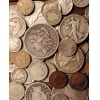|
 Collector’s coins or vintage coins have always been in
focus due to their value and exclusivity. Coins could be a good investment for
someone spending fortune to add some more of them to their collection. The others
prefer chasing the rare coin or the one of unusual shape. Coins can tell the
history and culture of the nation and the rules. Coins can not only be the part
of the numismatic collection but also the asset to be inherited and
appreciated. Collector’s coins or vintage coins have always been in
focus due to their value and exclusivity. Coins could be a good investment for
someone spending fortune to add some more of them to their collection. The others
prefer chasing the rare coin or the one of unusual shape. Coins can tell the
history and culture of the nation and the rules. Coins can not only be the part
of the numismatic collection but also the asset to be inherited and
appreciated.
A coin of the non-existing Emperor
Silver coins from 1825 with the image of Konstantin I,
the Emperor of Russia on the adverse side of the coin, are kept in two well-known
museums in Russia, in Hermitage and Moscow National Museum of History. Too few people
could remember reading about this Emperor in books of history. That was not a
mythical person, though but the sibling to Nikolay I who mounted the throne just
after the death of Aleksandr I, The Emperor, the eldest of the brothers, in 1825.
The succession to the throne should have been passed to the elder of the other brother
that is Konstantin. But there was the secret known to close people only. Well in
advance of the succession Konstantin demised secretly to marry the Polish countess
Joanna Grudzińska. Nevertheless, the guards could have managed to swear
to the new Emperor, while the National Mint issued the personalized currency in
coins. The coins then were not eliminated but were hidden in the special archive
at the Ministry of Finance. These rare coins famed only in 1879 when Aleksandr
II, the new Emperor, allocated the five coins between the family members and
the Hermitage museum collection. One of such coins with the image of Konstantin
was put to auction at Christie's in 1965 to be estimated for $100 tsd. US Dollars
and sold to an anonymous collector. None the less, the masters could make six coins
and two of them had no milled inscription and no one knows the fate of the
sixth one.
Most expensive coin in the world
A silver American dollar of 1794 manufacture was sold
in May 2010 for the record of $7 mln 850 tsd. USD. A female head with flying
hair was embossed on the adverse side of the coin to symbolize liberty. Fifteen
stars were placed by the image edges to symbolize fifteen states with the word-
Liberty and date 1794 placed in the center. The reverse of the coin depicted an
eagle that was a little bit lean from other images on other consequent coins,
an olive branch and the words United States of America. Apart from being an item
of value, the silver dollar was appreciated as the historical object since it
was one of the pioneer coins in the US history.
Unique coins
Coins are mainly associated with something round and
metal. However, there are some coins in the world that challenge the agreed standards
in all parameters. So, during the reign of Catherine I in Yekaterinburg a
copper coin was minted. This coin is exhibited in the collection of the Moscow National
Museum of History. This coin is square and is estimated to have the value of approximately
two million Russian roubles. Nevertheless, this is not the only square coin in
the world. So, in the beginning of XVII century in Sweden heavy copper dallers
were minted shaped as square slabs embossed from one and a half kilo of metal.
The most
unusual material for coin minting
was applied
in America.
The currency unit made from the shellfish was introduced
in 1933 in the coast town Pismo Beach, California. Shellfish-based currency was
used in modern America during the Great Depression period when people would lose
everything they had to survive in a flash and when lots of industrial facilities
got broke. The symbols of denominational value were applied in black ink onto the
pearl shell including the date of issue and other specific details the
traditional bank notes used to have. Even the well-known phrase «In God We
Trust» was applied onto the shell currency. The local Chamber of Commerce and
Industry accepted such currency and seashells of 25, 50 and 1 dollar nominal
value were put into circulation. Interesting, that seashells were good food
stuff during starving times and the town itself was named accordingly, Pismo
Beach.
The national currency unit accepted at Solomon Islands
is too far unique. This is a ring-shaped coin with two finials. The coin is made
from the sea-shell also. Only few islanders could master the technique of Bokolo
filing out which makes it attractive for many collectors and museums. However, this
currency unit is not in wide circulation against Solomon dollars accepted in
local supermarkets. 1 Bokolo is 5000 Solomon dollars or $37500 American dollars
and the native people pay in this money for the bride, land and negotiation
tool.
|